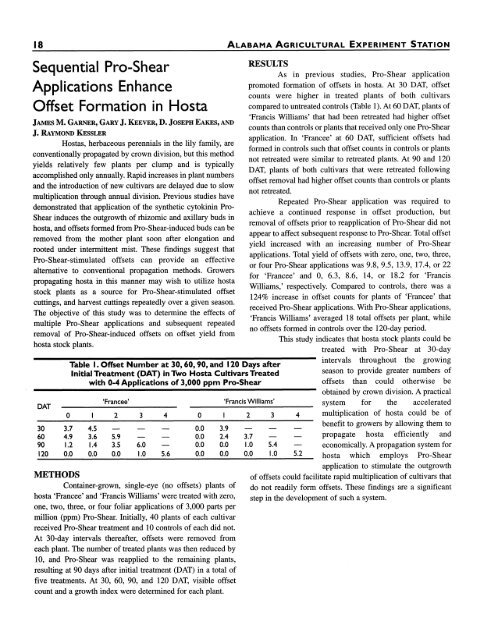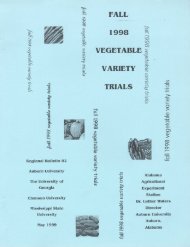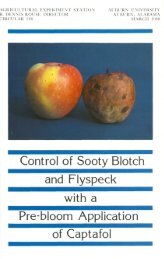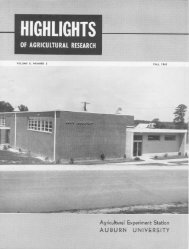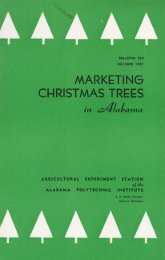1997 Ornamentals Research Report - AUrora - Auburn University
1997 Ornamentals Research Report - AUrora - Auburn University
1997 Ornamentals Research Report - AUrora - Auburn University
You also want an ePaper? Increase the reach of your titles
YUMPU automatically turns print PDFs into web optimized ePapers that Google loves.
18<br />
18<br />
Sequential Pro-Shear<br />
Applications Enhance<br />
Offset Formation in Hosta<br />
JAMES M. GARNER, GARY J. KEEVER, D. JOSEPH EAKES, AND<br />
J. RAYMOND KESSLER<br />
Hostas, herbaceous perennials in the lily family, are<br />
conventionally propagated by crown division, but this method<br />
yields relatively few plants per clump and is typically<br />
accomplished only annually. Rapid increases in plant numbers<br />
and the introduction of new cultivars are delayed due to slow<br />
multiplication through annual division. Previous studies have<br />
demonstrated that application of the synthetic cytokinin Pro-<br />
Shear induces the outgrowth of rhizomic and axillary buds in<br />
hosta, and offsets formed from Pro-Shear-induced buds can be<br />
removed from the mother plant soon after elongation and<br />
rooted under intermittent mist. These findings suggest that<br />
Pro-Shear-stimulated offsets can provide an effective<br />
alternative to conventional propagation methods. Growers<br />
propagating hosta in this manner may wish to utilize hosta<br />
stock plants as a source for Pro-Shear-stimulated offset<br />
cuttings, and harvest cuttings repeatedly over a given season.<br />
The objective of this study was to determine the effects of<br />
multiple Pro-Shear applications and subsequent repeated<br />
removal of Pro-Shear-induced offsets on offset yield from<br />
hosta stock plants.<br />
ALABAMA AGRICULTURAL EXPERIMENT STATION<br />
ALABAMA AGRICULTURAL EXPERIMENT STATION<br />
Table I. Offset Number at 30, 60, 90, and 120 Days<br />
after<br />
Initial Treatment (DAT) in Two Hosta Cultivarss<br />
Treated<br />
with 0-4 Applications of 3,000 ppm Pro-Shiear<br />
intervals throughout the growing<br />
season to provide greater numbers of<br />
offsets than could otherwise be<br />
obtained by crown division. A practical<br />
DAT<br />
30<br />
60<br />
90<br />
120<br />
0<br />
3.7<br />
4.9<br />
1.2<br />
0.0<br />
I<br />
4.5<br />
3.6<br />
1.4<br />
0.0<br />
'Francee'<br />
2<br />
-<br />
5.9<br />
3.5<br />
0.0<br />
3<br />
-<br />
-<br />
6.0<br />
1.0<br />
4<br />
-<br />
-<br />
-<br />
5.6<br />
0<br />
0.0<br />
0.0<br />
0.0<br />
0.0<br />
'Francis Williams'<br />
I 2 3<br />
3.9<br />
2.4 3.7<br />
-<br />
0.0 1.0<br />
5.4<br />
0.0 0. .0 1.0<br />
4<br />
-<br />
-<br />
5.2<br />
system for the accelerated<br />
multiplication of hosta could be of<br />
benefit to growers by allowing them to<br />
propagate hosta efficiently and<br />
economically. A propagation system for<br />
hosta which employs Pro-Shear<br />
METHODS<br />
Container-grown, single-eye (no offsets) plants of<br />
hosta 'Francee' and 'Francis Williams' were treated with zero,<br />
one, two, three, or four foliar applications of 3,000 parts per<br />
million (ppm) Pro-Shear. Initially, 40 plants of each cultivar<br />
received Pro-Shear treatment and 10 controls of each did not.<br />
At 30-day intervals thereafter, offsets were removed from<br />
each plant. The number of treated plants was then reduced by<br />
10, and Pro-Shear was reapplied to the remaining plants,<br />
resulting at 90 days after initial treatment (DAT) in a total of<br />
five treatments. At 30, 60, 90, and 120 DAT, visible offset<br />
count and a growth index were determined for each plant.<br />
RESULTS<br />
As in previous studies, Pro-Shear application<br />
promoted formation of offsets in hosta. At 30 DAT, offset<br />
counts were higher in treated plants of both cultivars<br />
compared to untreated controls (Table 1). At 60 DAT, plants of<br />
'Francis Williams' that had been retreated had higher offset<br />
counts than controls or plants that received only one Pro-Shear<br />
application. In 'Francee' at 60 DAT, sufficient offsets had<br />
formed in controls such that offset counts in controls or plants<br />
not retreated were similar to retreated plants. At 90 and 120<br />
DAT, plants of both cultivars that were retreated following<br />
offset removal had higher offset counts than controls or plants<br />
not retreated.<br />
Repeated Pro-Shear application was required to<br />
achieve a continued response in offset production, but<br />
removal of offsets prior to reapplication of Pro-Shear did not<br />
appear to affect subsequent response to Pro-Shear. Total offset<br />
yield increased with an increasing number of Pro-Shear<br />
applications. Total yield of offsets with zero, one, two, three,<br />
or four Pro-Shear applications was 9.8, 9.5, 13.9, 17.4, or 22<br />
for 'Francee' and 0, 6.3, 8.6, 14, or 18.2 for 'Francis<br />
Williams,' respectively. Compared to controls, there was a<br />
124% increase in offset counts for plants of 'Francee' that<br />
received Pro-Shear applications. With Pro-Shear applications,<br />
'Francis Williams' averaged 18 total offsets per plant, while<br />
no offsets formed in controls over the 120-day period.<br />
This study indicates that hosta stock plants could be<br />
treated with Pro-Shear at 30-day<br />
application to stimulate the outgrowth<br />
of offsets could facilitate rapid multiplication of cultivars that<br />
do not readily form offsets. These findings are a significant<br />
step in the development of such a system.


